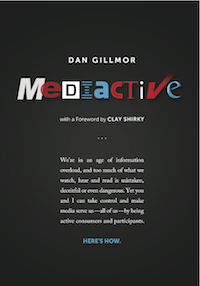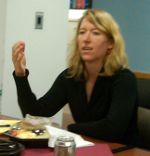
Dan Gillmor. Photo (cc) 2018 by New America.
Citizen journalism pioneer Dan Gillmor is moving on to a new phase of his career. Gillmor, whose 2004 book, “We the Media,” inspired a generation of activists, is retiring from Arizona State University, and will be working on a project aimed at promoting democracy and freedom of expression. He writes:
I am absolutely convinced that journalism’s most essential role at this critical moment goes far, far beyond what it’s doing. The status quo in political (and related) coverage consists of sporadically noting that gosh-maybe-there’s-a-problem, while sticking mostly to journalistic business as usual. The status quo is journalistic malpractice.
If I’m not mistaken, Gillmor was the first to refer to the public as “the former audience,” a phrase later picked up by New York University journalism professor Jay Rosen and many others, to describe the idea that the internet enables members of the public to communicate easily with journalists and among themselves. This idealistic vision was later corrupted by the giant tech platforms, but that doesn’t make it any less powerful — and maybe at some point we can get back to that.
Gillmor inspired not just non-journalists but journalists as well. Boston newspaper veteran Bob Sprague, the retired founder of the nonprofit digital news organization yourArlington, in the Boston suburbs, told Ellen Clegg and me on our “What Works” podcast that he decided to start covering his community shortly after reading “We the Media.”
In 2006 I wrote a profile of Gillmor for CommonWealth Magazine (now CommonWealth Beacon) after he founded the Center for Citizen Media at Harvard Law School, a project that has since ended. Here’s what he told me about his vision for citizen media:
If the right people join in the conversation, it will inevitably get richer and richer. The practical problems are many. How do you get knowledgeable people to join? How do you moderate things, if it’s a large conversation, [in a way] that pushes forward the subject? How do you elevate the signal out of the noise? I happen to think that’s one of the core issues we need to address in citizen media. How do you address the fact that most people don’t have the time to read every comment on every relevant blog?
We still see the spirit of Gillmor’s original ideas here and there. One of the projects that Ellen and I write about in our book, “What Works in Community News,” is The Bedford Citizen, yet another project in Boston’s suburbs. Unlike Bob Sprague, who was already a longtime journalist, the Citizen was started by three volunteers, only one of whom had any journalism experience. Since then the nonprofit website has growing into a professional news organization with a paid editor.
There’s also the Documenters project, which pays members of the public to cover public meetings — a key ingredient that was missing from the original notion of citizen journalism.
Congratulations and good luck to Dan Gillmor on his latest venture.



 With the publication of his 2004 book
With the publication of his 2004 book 